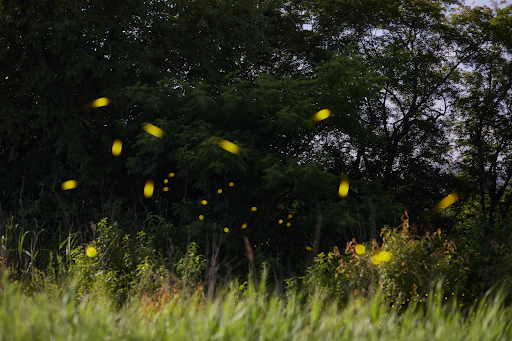There is a certain art to finding fireflies, and it comes down to understanding suitable habitats for common species in your area. As a child, you may have turned off your house lights and used a flashlight to attract fireflies, desperate to catch a glimpse of these bioluminescent creatures. These flashing beetles generate a sense of amazement during the summertime and pose a challenge to young kids (and scientists) who hope to catch one. Unfortunately, the opportunity to observe a firefly spectacle decreases every day.
The reduction of firefly populations began in the 1940s with the commercial overharvesting of firefly populations for medical advancements. Scientists discovered that the luciferase gene in the firefly could be extracted and used to detect the expression of another gene in an organism. Luciferase is the enzyme that allows fireflies to produce light and has been used for various applications: monitoring tumor growth, detecting bacteria in soda and milk, testing for COVID-19 antibodies, and repelling sharks! Luciferase can be implanted to detect the location and size of tumors weeks sooner than traditional methods, and the test for contamination and spoilage in drinks measures how much light is released which is proportional to how much bacteria is present. COVID-19 diagnostic testing has also improved because antibodies can be detected up to four hours after infection compared to one to two days! To test luciferase as a shark repellant, it was added to a shark tank which caused some sharks to attempt an escape from the tanks while others became immobile and died. Due to these many uses, organizations placed a price on fireflies to encourage young people to collect fireflies, which led to approximately 100 million fireflies being caught from 1940 to around the 1990s.

Starting in 1985, a synthetic alternative of luciferase became available, so fireflies are not sacrificed in such great demand for these medical research studies. Despite the fact that there is now a synthetic alternative, the populations continue to decline, not primarily due to firefly hunting, but as a result of habitat destruction, artificial light pollution, and pesticide use. Approximately two-thirds of humans reside in cities that have exceeded the threshold for light pollution levels suitable for fireflies. Since fireflies flash their lights to attract mates, artificial light hinders their ability to communicate and reproduce. Some ways to reduce the effects of artificial lights on firefly mating rituals are to direct the beams downward and use motion detection sensors, so light comes on only when actively used by city goers. Pesticides have a heavy impact on firefly habitats and populations because pesticides seep into the soil where larvae live for 1-2 years of their life cycle. This also affects their food supply and fireflies in their adult stage, which live close to pesticide-contaminated waters. Urbanization can divide firefly populations, which can limit the diversity of fireflies and the health of the ecosystem. With the current designs of urban areas, there is very little consideration for biodiversity and non-human dominated green spaces. By making city-wide and household changes, we can make the first steps to mitigating the devastating loss of fireflies.

Several minor alterations can be made to your routine to tackle the decline of firefly populations. This may include turning off porch lights at night, allowing the grass in green spaces to grow a little taller, accumulating leaf litter to provide a suitable habitat for larvae, and limiting the use of pesticides. Other actions may include monitoring fireflies in your area or picking up litter along roadsides or riversides! UGA graduate student Margot Popecki who studies fireflies in the Genetics and Plant Biology Departments was able to do just that with the help of her friends. Margot shares that “adult fireflies need a safe, clean environment for their light displays and to lay their eggs. Some types of firefly larvae live in the ground, so it’s important to maintain firefly habitats for them to thrive and use the space year after year.”
Firefly populations were truly decimated due to the collection of fireflies for luciferase during the 1940s-1990s and any potential rebound of firefly numbers is complicated by other factors such as artificial light, pesticides, and habitat fragmentation; therefore, now is time to return the favor by reducing our impact on their habitats. Hold on tight to the childlike wonder you used to feel when chasing fireflies on warm summer nights by protecting these species and ensuring that future generations have the opportunity to experience the same sense of magic.
About the Author
Nicole Steel is a second-year undergraduate at the University of Georgia studying Biology and Ecology. Her main interests are conservation, medicine, and health equity. Outside of school, she enjoys hiking, reading, and listening to music. You can reach her at nes43678@uga.edu
- This author does not have any more posts.






